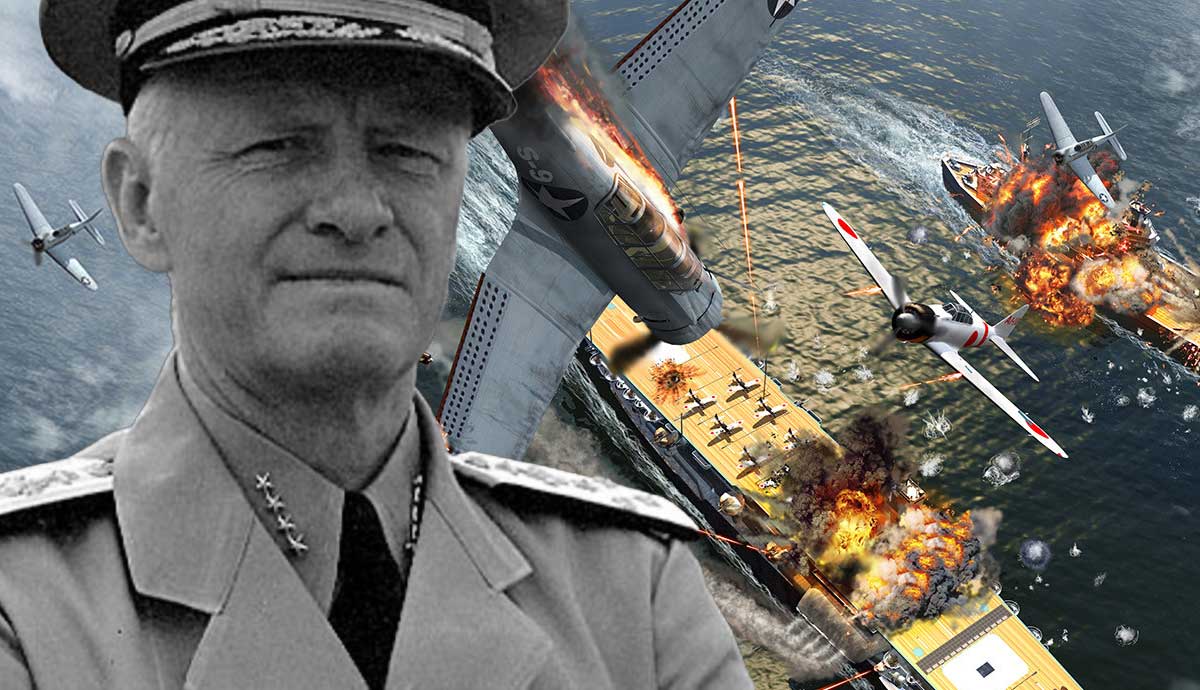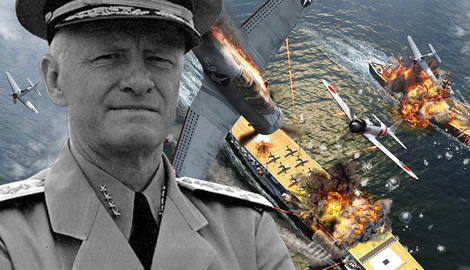
On December 7, 1941, the Japanese attacked Pearl Harbor. It took the United States by surprise and was a great blow to the US Navy, which lost four battleships and 188 aircraft, among many other losses. The United States began rapidly preparing its navy for an inevitable clash with the Imperial Japanese Navy that would surely attempt to follow up its attack with a naval victory.
The Battle of the Coral Sea that followed from May 4 to 8, 1942 proved inconclusive, but the US lost an aircraft carrier, the USS Lexington, and the Japanese claimed a tactical victory. The following month would see the two mighty navies clash in a gargantuan naval engagement known as the Battle of Midway.
The Japanese Plan for the Battle of Midway

For the Imperial Japanese Navy to gain supremacy over the United States in the Pacific, Marshal Admiral Isoroku Yamamoto compiled a complex plan to sink the US aircraft carriers that he saw as central to the US ability to project meaningful military force. His fears of US carrier abilities were well-founded. On April 18, US bombers took off from carriers and bombed targets in Japan. Although militarily insignificant, the Doolittle Raid proved the effectiveness of carrier warfare while boosting the morale of the US, which had yet to gain any significant victories against the Japanese.
Yamamoto wanted to lure the US carrier groups out, and in order to do that, he needed to threaten US possessions in the Pacific. Hawaii had been fortified since the attack on Pearl Harbor, so Yamamoto chose the Midway Islands, a vital refueling station and home to a US submarine base.

For the Japanese plan to work, there needed to be precision, as it would rely on carefully coordinated movements from multiple battle groups across the open ocean. Yamamoto dispersed the elements of the Japanese attack groups to lower the risk of one large battle group being spotted. The drawback to this was that the ships were too far away to be able to provide support in time.
The plan also relied on intelligence that, in the end, proved to be faulty. Many assumptions were made about US ship statuses which proved to be incorrect. To add to this, the Americans had broken some of the Japanese codes and were aware of much of what was happening.
The Japanese plan seemed doomed before a single shot was fired, but Yamamoto did not know any of this at the time.
The US Prepares for Battle

US Commander-in-chief of the Pacific Area, Admiral Chester Nimitz, realized that to be able to confront the Japanese forces successfully, the US would need at least four or even five carriers. Every inch of available flight deck would be needed to carry all the necessary aircraft. The USS Enterprise and the USS Hornet were already available, and Nimitz recalled the USS Yorktown from the Southwest Pacific. It had been damaged in the Battle of Coral Sea, and repairs went on around the clock, even continuing as the ship went into combat. Ultimately, Nimitz could only muster three carriers.
Replacing the airplanes was also a major task, and stationing as many as possible on Midway was a top priority. Everything available was scraped together, including obsolete planes and torpedoes.
The Fighting Begins

On June 3, at about midday, the fighting began. American patrols had spotted one of the Japanese groups. Nine B-17 bombers took off from Midway on a course to intercept. They reached a transport group and immediately encountered heavy anti-aircraft fire. The aircrews dropped their bombs and returned home, causing no significant damage to the Japanese.
Early in the morning on June 4, the Japanese struck the island of Midway. Over 100 aircraft took off. They were spotted by the Americans an hour after they left their decks. They scrambled to intercept, and a furious air battle took place, with the Japanese gaining the upper hand, destroying many US aircraft with comparatively few losses of their own. Despite this, however, they failed to do any major damage to the runways on Midway, and the Americans were still able to launch their own aircraft in a counter-attack. The American anti-aircraft fire was effective and damaged many of the attacking aircraft.
US bombers already in the air reached their targets around 07:30. The Japanese managed to repel the attacks while losing only three aircraft in the process. American pilots showed immense bravery, with one bomber getting close to the aircraft carrier Akagi and strafing it at such a close range that anti-aircraft gunners could not fire for fear of hitting their own ship. While this was happening, the Japanese fleet was harassed by a US submarine, the Nautilus, which, although it did not manage to cause any damage, kept some of the Japanese ships occupied.

The Americans, with hurried defenses, struggled to match the launch efficiency of the Japanese. It meant that the US aircraft would arrive in piecemeal groups at the target area. While this would mean suffering more casualties, it also meant that the Japanese had little room to organize a counter-attack, as they would be under constant attack.
With underperforming, obsolete aircraft and poor-quality torpedoes, the Americans suffered heavily in the initial stages of the battle. Aircraft were shot down, ditched, and ran out of fuel trying to locate the enemy, while their Mark 13 torpedoes missed their targets by running too deep under the water, failing to detonate, or exploding too soon.
Hit!

While many of the Japanese ships were engaged in the piecemeal attacks from American planes, they were pulled out of formation and became vulnerable to attacks from multiple directions.
With skill and a fair amount of luck, three American dive bomber squadrons managed to reach the target area at the same time. Despite confusion over which individual ships they were supposed to attack, three of Japan’s four carriers were put out of action. The Sōryū, Kaga, and Akagi were ablaze and had to be abandoned.
With only one carrier left, the Hiryū, now facing the three carriers the US had mustered, US forces were now in a favorable position but would still have to sustain the imminent Japanese counter-attack.
The Japanese Strike Back

The Hiryū immediately struck back, launching 18 dive bombers with six fighter escorts. This group followed the American planes returning to their carriers and hit the first target they encountered. The carrier USS Yorktown suffered significant damage, with three bombs blowing a hole in the deck and destroying most of the boilers. Reduced to a maximum speed of five knots, the ship became an easy target for a second wave of bombers.

The repairs done on the carrier were so quick and effective that the second wave of bombers that arrived an hour after the first wave assumed it was a different carrier. This time the ship was struck with two torpedoes and began to list to port.
Thinking they had put two American aircraft carriers out of action, the Japanese mistakenly thought they only had one aircraft carrier to deal with. Despite the loss of many aircraft in the attacks, Japanese morale surged.
The Americans Attack Again

The Japanese boost to morale was short-lived. The USS Enterprise launched 26 dive-bombers at the remaining Japanese carrier. There weren’t enough Japanese Zero fighters to fend off the attack, and at least four bombs hit their mark, with one hitting the Hiryū directly on the bow. This crippled the ship, and blazes spread across the flight deck.
The other US carrier, the USS Hornet, launched its attack late due to a communications error. The attack concentrated on the Hiryū’s escort ships but failed to inflict any losses.
As night fell, it was clear that the Americans had won the contest between the carriers. There was still, however, the danger of the rest of the Japanese fleet, and fearing that a night engagement would find the American carriers overwhelmed and sunk, the Americans decided to withdraw east.
Over the next few days, the Americans continued to search for Japanese ships. They made piecemeal attacks that sank a heavy cruiser, the Mikuma, and crippled two destroyers, Arashio and Asashio.
The Japanese struck the last blow, however, when a Japanese submarine torpedoed the Yorktown, finishing the ship off. The USS Hammann, which was providing help repairing the Yorktown, was struck as well. The ship broke in two, and 80 lives were lost as the ship sank.

The Battle of Midway was an undeniable victory for the United States. It had sunk four Japanese fleet carriers, losing only one American carrier. Over 3,000 Japanese lives were lost, with the Americans losing a tenth of that figure. The assets on Midway had been defended, which would severely hamper Japanese attempts to expand into the Pacific. In terms of aircraft lost, the Japanese also came off worse. With no carriers to support them, Japan lost all of its 248 aircraft used in the battle to the US loss of 150.
The Battle of Midway was a turning point in the war. The initiative now lay with the Americans, and they were able to go on a general offensive.
Midway allowed the balance of power to be shifted in favor of the Americans, who realized their ascendancy and pressed home their new advantage, eventually leading to a complete Japanese defeat three years later.











